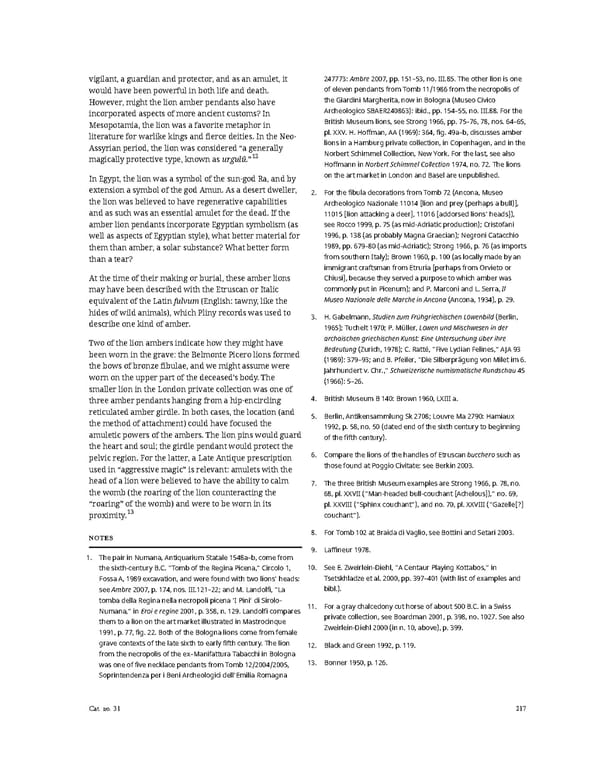vigilant, a guardian and protector, and as an amulet, it 247773: Ambre2007, pp. 151–53, no. III.85. The other lion is one would have been powerful in both life and death. of eleven pendants from Tomb 11/1986 from the necropolis of However, might the lion amber pendants also have the Giardini Margherita, now in Bologna (Museo Civico incorporated aspects of more ancient customs? In Archeologico SBAER240863): ibid., pp. 154–55, no. III.88. For the Mesopotamia, the lion was a favorite metaphor in British Museum lions, see Strong 1966, pp. 75–76, 78, nos. 64–65, literature for warlike kings and fierce deities. In the Neo- pl. XXV. H. Hoffman, AA (1969): 364, fig. 49a–b, discusses amber Assyrian period, the lion was considered “a generally lions in a Hamburg private collection, in Copenhagen, and in the magically protective type, known as urgulû.”12 Norbert Schimmel Collection, New York. For the last, see also Hoffmann inNorbert Schimmel Collection 1974, no. 72. The lions In Egypt, the lion was a symbol of the sun-god Ra, and by on the art market in London and Basel are unpublished. extension a symbol of the god Amun. As a desert dweller, 2. For the fibula decorations from Tomb 72 (Ancona, Museo the lion was believed to have regenerative capabilities Archeologico Nazionale 11014 [lion and prey (perhaps a bull)], and as such was an essential amulet for the dead. If the 11015 [lion attacking a deer], 11016 [addorsed lions’ heads]), amber lion pendants incorporate Egyptian symbolism (as seeRocco 1999, p. 75 (as mid-Adriatic production); Cristofani well as aspects of Egyptian style), what better material for 1996, p. 138 (as probably Magna Graecian); Negroni Catacchio them than amber, a solar substance? What better form 1989, pp. 679–80 (as mid-Adriatic); Strong 1966, p. 76 (as imports than a tear? from southern Italy); Brown 1960, p. 100 (as locally made by an immigrant craftsman from Etruria [perhaps from Orvieto or At the time of their making or burial, these amber lions Chiusi], because they served a purpose to which amber was may have been described with the Etruscan or Italic commonly put in Picenum); and P. Marconi and L. Serra, Il equivalent of the Latin fulvum (English: tawny, like the Museo Nazionale delle Marche in Ancona (Ancona, 1934), p. 29. hides of wild animals), which Pliny records was used to 3. H. Gabelmann,Studien zum Frühgriechischen Löwenbild (Berlin, describe one kind of amber. 1965); Tuchelt 1970; P. Müller, Löwen und Mischwesen in der Two of the lion ambers indicate how they might have archaischen griechischen Kunst: Eine Untersuchung über ihre been worn in the grave: the Belmonte Picero lions formed Bedeutung(Zurich, 1978); C. Ratté, “Five Lydian Felines,” AJA 93 the bows of bronze fibulae, and we might assume were (1989): 379–93; and B. Pfeiler, “Die Silberprägung von Milet im 6. worn on the upper part of the deceased’s body. The Jahrhundert v. Chr.,” Schweizerische numismatische Rundschau 45 smaller lion in the London private collection was one of (1966): 5–26. three amber pendants hanging from a hip-encircling 4. British Museum B 140: Brown 1960, LXIII a. reticulated amber girdle. In both cases, the location (and 5. Berlin, Antikensammlung Sk 2708; Louvre Ma 2790: Hamiaux the method of attachment) could have focused the 1992, p. 58, no. 50 (dated end of the sixth century to beginning amuletic powers of the ambers. The lion pins would guard of the fifth century). the heart and soul; the girdle pendant would protect the pelvic region. For the latter, a Late Antique prescription 6. Compare the lions of the handles of Etruscan bucchero such as used in “aggressive magic” is relevant: amulets with the those found at Poggio Civitate: see Berkin 2003. head of a lion were believed to have the ability to calm 7. The three British Museum examples are Strong 1966, p. 78, no. the womb (the roaring of the lion counteracting the 68, pl. XXVII (“Man-headed bull-couchant [Achelous]),” no. 69, “roaring” of the womb) and were to be worn in its pl. XXVIII (“Sphinx couchant”), and no. 70, pl. XXVIII (“Gazelle[?] proximity.13 couchant”). NOTES 8. For Tomb 102 at Braida di Vaglio, see Bottini and Setari 2003. 9. Laffineur 1978. 1. The pair in Numana, Antiquarium Statale 1548a–b, come from the sixth-century B.C. “Tomb of the Regina Picena,” Circolo 1, 10. See E. Zweirlein-Diehl, “A Centaur Playing Kottabos,” in Fossa A, 1989 excavation, and were found with two lions’ heads: Tsetskhladze et al. 2000, pp. 397–401 (with list of examples and seeAmbre2007, p. 174, nos. III.121–22; and M. Landolfi, “La bibl.). tomba della Regina nella necropoli picena ‘I Pini’ di Sirolo- 11. For a gray chalcedony cut horse of about 500 B.C. in a Swiss Numana,” inEroi e regine 2001, p. 358, n. 129. Landolfi compares private collection, see Boardman 2001, p. 398, no. 1027. See also them to a lion on the art market illustrated in Mastrocinque Zweirlein-Diehl 2000 (in n. 10, above), p. 399. 1991, p. 77, fig. 22. Both of the Bologna lions come from female grave contexts of the late sixth to early fifth century. The lion 12. Black and Green 1992, p. 119. from the necropolis of the ex–Manifattura Tabacchi in Bologna was one of five necklace pendants from Tomb 12/2004/2005, 13. Bonner 1950, p. 126. Soprintendenza per i Beni Archeologici dell’Emilia Romagna Cat. no. 31 217
 Ancient Carved Ambers in the J. Paul Getty Museum Page 226 Page 228
Ancient Carved Ambers in the J. Paul Getty Museum Page 226 Page 228